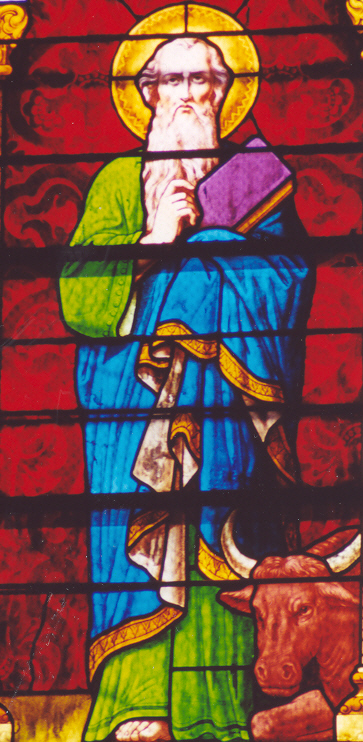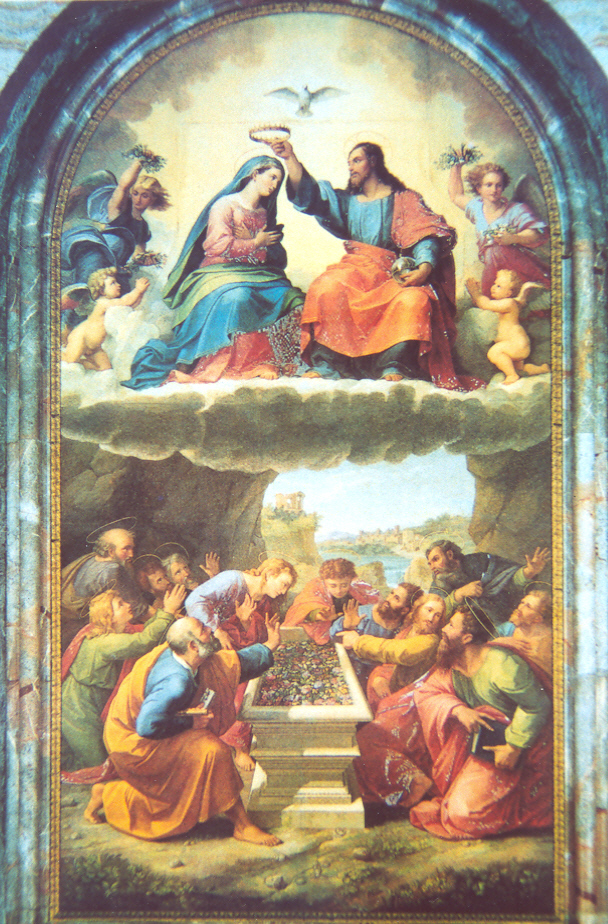
The Assumption of the
Blessed Virgin Mary
A Homily - C Cycle 2003-2004
First Reading - Revelation 11:19a; 12:1-6a, 10ab
Psalm - 45:10,11,12,16
Second Reading - 1 Corinthians 15:20-27
Gospel - Luke 1:39-56
Luke writes to explain that
Christ came to save everyone.

Mary set out and traveled to the hill country in haste to a town of Judah, where she entered the house of Zechariah and greeted Elizabeth. When Elizabeth heard Mary's greeting, the infant leaped in her womb, and Elizabeth, filled with the Holy Spirit, cried out in a loud voice and said, "Blessed are you among women, and blessed is the fruit of your womb. And how does this happen to me, that the mother of my Lord should come to me? For at the moment the sound of your greeting reached my ears, the infant in my womb leaped for joy. Blessed are you who believed that what was spoken to you by the Lord would be fulfilled." And Mary said:
“My soul proclaims the greatness of the Lord; my spirit rejoices in God my Savior for he has looked upon his lowly servant. From this day all generations will call me blessed: the Almighty has done great things for me, and holy is his Name. He has mercy on those who fear him in every generation. He has shown the strength of his arm, and has scattered the proud in their conceit. He has cast down the might from their thrones, and has lifted up the lowly. He has filled the hungry with good things, and the rich he has sent away empty. He has come to the help of his servant Israel for he has remembered his promise of mercy, the promise he made to our fathers, to Abraham and his children for ever.” Mary remained with her about three months and then returned to her home.
As I was incensing the altar at the beginning of Mass, I was reminded of a time last year when I was saying Mass for the nuns at Our Lady of the Angels Monastery in Hanceville, Alabama, where Mother Angelica and the Poor Clare's have a monastery. The altar boy put too many coals in the thurible so that I could not close the lid of the thurible and when I began swinging the incense, shards of burning coals began to fly out over the altar linens and the sanctuary. Keep in mind that the entire sanctuary is made of marble and so 3 extern nuns rushed into the sanctuary with cloths to clean up my mess and with each swing of the thurible, I kept thinking, "This is probably the last time I say Mass here." After the Mass, I was joking with the nuns that they probably have a wall full of pictures of priests who are not allowed to offer Mass at the monastery. They were stone-faced. Maybe they do have that list. . .

In the Basilica of St. Paul Outside the Walls in Rome, there is a wonderful painting that hangs in the right transept,. depicting the subject of today's solemnity. The painting shows the Apostles gathered around the tomb of Mary. As they look down into the tomb, they find only flowers in there and no corpse. Some of the Apostles gaze heavenward, where Mary is depicted in the heavens, receiving her crown as Queen of Heaven and Earth. The painting combines both artistry and faith content all in the same moment.
The Dogma of the Assumption is the most ancient feastday of Our Lady - it has been celebrated by the East since before the year of 500. In the West, St. Gregory of Tours wrote about the Assumption as early as the 6th century. It is one of the most unique dogmas defined by the Church because practically every other dogma of the Church had been defined in response to a doubt or an attack on an element of the Faith. For example, the Apostles Creed, formulated at the Council of Jerusalem in 53 AD was written in response to doubts about the person of Christ. In the 300's the Nicene-Constantinople Creed which we recite each Sunday and Solemnity, further defended both the divinity and the humanity of Jesus.
When Pius XII defined the dogma of the Assumption, it was not because the belief was in question. However, Pius XII, writing in the aftermath of the atrocities of two world wars wanted to re-assert the ancient Catholic belief in the dignity of the human body. By this dogma, Pius XII wanted Catholics and Christians everywhere to be reminded that already, Mary was enjoying the beatific vision of God in body and soul. She enjoys now what we all hope to enjoy at the Final Judgment. The body will very much be a part of the life of the world to come. Mary's Assumption is a reminder of this.
This is also a pre-feminist solemnity. As Catholics, we believe that it is not only the God-man, Jesus Christ, who is in heaven, body and soul but that a woman is as well - Mary. We are the only Christians who believe that both a man and a woman already enjoy the glorified state. Protestants hold that only Christ is in His glorified state, not Mary. Isn't it striking that for as much as the Church is called anti-woman, we are the only Christians who believe a woman is already in her glorified state. As I mentioned earlier, today we celebrate the fact that Mary enjoys now in her body and soul what we anticipate at the end of time. When the rest of us die, our bodies remain here on the earth (usually buried somewhere) and our souls face particular judgment. It will only be at the resurrection of the dead that our souls and bodies will be reunited in their glorified state. Purgatory will cease to exist at the final judgment and only heaven and hell will remain.
I find it fascinating that in a Church like ours that has as deep a tradition venerating relics as we do, there has never, ever been a tradition or claim on possession of the relics of Mary. That's because there aren't any. Her tomb in Ephesus, which is in modern-day Turkey, is empty. So, what happened to Mary? Did she die? Or, as the East holds, did she merely fall asleep? The East celebrates this Solemnity as the Dormition (or the falling asleep) of Mary, not the Assumption.
Pius XII cleverly avoided making this distinction between dying and falling asleep because both positions are tenable. If she fell asleep, then she was assumed body and soul into heaven after that. If she "died", she would not have felt any pain or suffered corruption because she was without sin. Her dying, then, would have resembled falling into a deep sleep. This Solemnity really only makes sense in light of the Immaculate Conception. That was defined in 1854 by Pope Pius IX. If Mary was conceived without sin, she could not have died in the same way that we do. She had no need to be buried because her body was free of corruption. So, it only stands to reason that her body and soul were immediately assumed into heaven where she was made Queen of Heaven and Earth.
Is any of this in Scripture? Not literally. The closest reference we have to it is found in St. John's Book of Revelation when he describes a woman clothed with the Sun with the moon at her feet and wearing a crown of stars. In the Old Testament, two figures, Elijah and Enoch were taken into the next life without dying. In spite of a lack of direct Scriptural, keep in mind that the Gospels aren't about Mary - they're about Jesus. This is a perfect example of how we Catholics see the Scriptures as emanating from our Tradition, not vice-versa. Most Protestants reject belief in the Assumption because it seems to lack a Scriptural "proof text." Most Protestants hold that the Bible alone is to determine what Christians should believe. For Catholics, it is not so. For us, we hold that doctrines don't need to be in Scripture in order to be found to be true because Scripture itself does not teach that it itself is the source of all doctrine. Besides, the Tradition of the Church pre-dates the composition of the Scriptures as we now know them, so it is obviously legitimate and logical to conclude that the Church relied on Tradition long before it relied on Scripture in order to develop doctrine, including that of the Assumption.
Finally, we do well to take pause of what a terrifically pro-life Gospel scene we have today - the timeless depiction of the 2nd Joyful Mystery - Visitation. In this scene, taken from the Gospel of St. Luke, we find the hope of humanity in all of its simplicity and humility. We are presented with Mary, the Virgin-Mother of the Savior, who arrives at the home of Elizabeth, pregnant with John the Baptist, who leaps in her womb. Leaps in her womb - which indicates, that the infant had God-awareness while still in the womb! Phenomenal! What an incredible scene - two cousins, pregnant with the future, the hope and the salvation of the human race.
As we continue our celebration of this solemnity, let us entrust ourselves more deeply to the maternal care of our Queen enthroned in heaven. May we live in a way that befits us to be called her children. She is our life, our sweetness and our hope - for she lives now in a state of perfection that we all hope to live in one day in heavenly glory. I would like to close with a prayer to Our Lady Assumed into Heaven:
Father, you prepared the Virgin Mary to be the worthy mother of your Son. You let her share beforehand in the salvation Christ would bring by His Death, and kept her sinless from the first moment of her conception. Help us by her prayers to live in Your presence without sin.
Oh, Mary, conceived without sin - pray for us who have recourse to thee.
Praised be Jesus Christ. Now and forever!
If you find this material
valuable, consider a tax deductible gift to support this site.
The DaCapo Foundation • 2402 Tricia Ct. • Vienna VA 22181